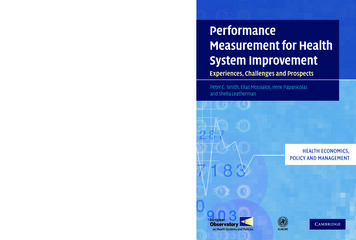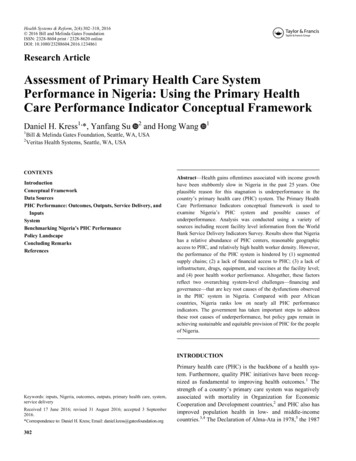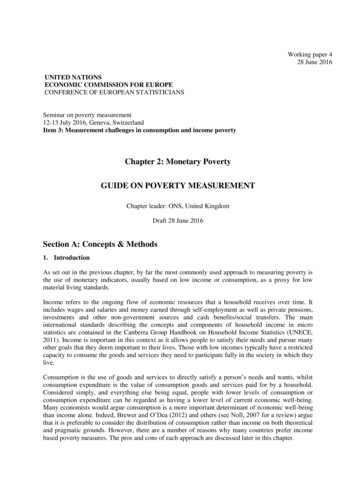
Transcription
Peter C. Smith is Professor of Health Policy at the Imperial CollegeBusiness School.Elias Mossialos is Professor of Health Policy at the London Schoolof Economics and Political Science, Co-Director of the EuropeanObservatory on Health Systems and Policies and Director of LSEHealth.Irene Papanicolas is Research Associate and Brian Abel SmithScholar, LSE Health, London School of Economics and PoliticalScience.Sheila Leatherman is Research Professor at the Gillings School ofGlobal Public Health, University of North Carolina and VisitingProfessor at the London School of Economics and Political Science.PRAISE QUOTES TO FOLLOWPerformanceMeasurement for HealthSystem ImprovementExperiences, Challenges and ProspectsPerformance Measurement forHealth System ImprovementTechnical material is presented in an accessible way and is illustratedwith examples from all over the world. Performance Measurement forHealth System Improvement is an authoritative and practical guide forpolicy makers, regulators, patient groups and researchers.Smith, Mossialos,Papanicolas andLeathermanIn a world where there is increasing demand for the performanceof health providers to be measured, there is a need for a morestrategic vision of the role that performance measurement can playin securing health system improvement. This volume meets thisneed by presenting the opportunities and challenges associatedwith performance measurement in a framework that is clear andeasy to understand. It examines the various levels at which healthsystem performance is undertaken, the technical instruments andtools available, and the implications using these may have for thosecharged with the governance of the health system.Peter C. Smith, Elias Mossialos, Irene Papanicolasand Sheila LeathermanHEALTH ECONOMICS,POLICY AND MANAGEMENTDesigned by Zoe Naylor
pa rt i vPerformance measurement inspecific domains
4.1Performance measurementin primary carehelen lester, martin rolandIntroductionThis chapter explores the value and complexities of measuring performance in primary care. We begin with a definition of primary care anda description of its importance within the wider health-care system.We then explore the importance of measuring performance in this setting and provide an overview of some of the quality improvementstrategies currently in use. The second part of the chapter describesa conceptual framework for quality measurement and reporting; thequalities of an ideal performance measure; and the relative value ofprocess and outcome measures within primary care. The third partdescribes three very different primary-care focused systems in whichperformance measurement has been critical to improving health care:(i) Quality and Outcomes Framework in the United Kingdom; (ii)changes in the Veterans Health Administration in the United States;and (iii) European Practice Assessment. We conclude by highlightingchallenges that policy-makers, researchers and clinicians face in futureperformance measurement in primary care.Background to performance measurement in primary careDefining primary careWHO made the improvement of primary health care a core policy inthe Alma-Ata declaration (WHO 1978) and the Health for All by theYear 2000 strategy. The World Health Assembly renewed the commitment to global improvement in health (particularly for the mostdisadvantaged populations) in 1998 and this led to the Health for Allin the 21st Century policy and programme.The term ‘primary care’ has different meanings in different countries. The providers of primary care may be general practitioners, family physicians, specialists working in the community, nurses or nurse371
372Performance measurement in specific domainspractitioners and (perhaps) physicians’ assistants. These practitionersmay work in solo practices or in large multi-professional groups andmay or may not be integrated with social and community services.Some will have a gatekeeper function to secondary care. Methods offunding primary care also vary from payment by the patient to payment by the state, with a variety of combinations in between.Primary care is better described in terms of its function rather thanits location. The American Institute of Medicine (Donaldson et al.1996) defined primary care as: ‘the provision of integrated, accessiblehealth care services by clinicians who are accountable for addressinga large majority of personal health care needs, developing a sustainedpartnership with patients and practising in the context of family andcommunity’. This builds on Starfield’s earlier definition of primarycare as ‘first-contact, continuous, comprehensive, and coordinatedcare provided to populations undifferentiated by gender, disease, ororgan system’ (Starfield 1994).The critical elements of primary care are: first-contact accessible services where demands are clarified andinformation, reassurance or advice are given and diagnoses made; provision of comprehensive services to meet the needs of patients,with focus on generalism rather than specialism; provision of patient-centred rather than disease-centred care; provision of a longitudinal relationship between an individualpatient and his/her health-care provider; coordination of care for individual patients; integration of biomedical, psychological and social dimensions of apatient’s problem; focus on health promotion and disease prevention as well as management of established health problems.In many countries, the primary-care provider also acts as an advocate for patients as they move through often complex health-caresystems.It has been demonstrated both between and within countries thatthose with a strong system of primary care have more efficient healthsystems and better health outcomes than those with a strong focuson hospital services (Macinko et al. 2007; Starfield 1998; Starfield etal. 2005). Countries with high primary care physician to populationratios (but not specialist to population ratios) have healthier popula-
Performance measurement in primary care373tions and fewer social inequalities in the health of their populations.Primary care therefore has an equity-producing effect, at least forthose measures of health that are most responsive to primary care (seeBox 4.1.1).Box 4.1.1 Benefits of primary careCountries with strong primary care: have lower overall costs generally have healthier populations.Within countries: areas with higher availability of primary-care physicians (butnot specialists) have healthier populations; higher availability of primary-care physicians reduces the adverseeffects of social inequality.Source: from Starfield 1998General practice or family medicine is a core discipline withinprimary care – in Europe, primary care is not easily conceptualizedwithout general practice. However, primary care encompasses considerably more than general practice alone. In countries in which generalpractice is well-developed, the functions and characteristics of primarycare largely overlap with those of general practice and general practicemay have a preferred position in primary care. In other countries, specialists in internal medicine, paediatrics and gynaecology also provideprimary medical care that is directly accessible.Importance of measuring performance in primary careIn order to understand the importance of measuring performance inprimary care it may be helpful to remember the ecology of medicalcare. White et al. (1961) published a framework for thinking aboutthe organization of health care. Inspired in part by careful reportingon the part of British general practitioners (Horder & Horder 1954),this conceptualization suggested that in an average month and in apopulation of 1000 adults – 750 reported an illness, 250 consulted aphysician, 9 were hospitalized, 5 were referred to another physician
374Performance measurement in specific domainsand just 1 was referred to a university medical centre. Analysis of1995-1996 data on the use of health care in the United States (Greenet al. 2001) had remarkably similar findings although undertakenthirty years later and in a different country. Among 1000 men, womenand children they found that (on average each month) – 800 experienced symptoms, 327 considered seeking medical care, 217 visited aphysician in the office (113 to a primary-care physician; 104 to otherspecialists), 65 visited a professional provider of complementary oralternative medical care, 21 visited a hospital-based outpatient clinic,14 received professional health services at home, 13 received care in anemergency department, 8 were hospitalized and less than 1 (0.7) wasadmitted to an academic medical centre hospital (Green et al. 2001).In essence, most people with symptoms manage them within thecommunity; if they do seek help they use the equivalent of primarycare, with very few people referred on for specialist care. Primary careis therefore the cornerstone of most health-care systems and measurement of its performance plays a critical part in ensuring that the wholesystem works effectively, efficiently and for the benefit of patients.However, professional acceptance of the need to measure performance in primary care is relatively recent. Until the 1980s, there was awidespread notion in most European countries and in the United Statesthat there was little variation in medical practice and that one doctorwas much like another. The British government’s attempts to introducemeasures of performance in 1986 were described as ‘political and provocative’ (British Medical Association 1986). The international rise ofevidence-based medicine (Sackett et al. 1996) and a growing realization of variations in practice meant that measurement of performancebecame a higher priority for both primary-care practitioners and policy-makers during the 1990s. Studies began to highlight inappropriateoveruse, underuse and misuse of procedures in a variety of differentfields (McGlynn et al. 1994). Much of the initial research focused onspecialist practice but subsequent studies found considerable variationin the quality of primary care (Mangione-Smith et al. 2007; McGlynnet al. 2003; Seddon et al. 2001). This was accompanied by a widergeneral recognition that medical error can be an important cause ofharm to patients (Kohn et al. 2000). In the United Kingdom, a series ofwell-publicized ‘scandals’ in primary and secondary care heightenedconcern that physicians should not be solely responsible for their ownclinical governance and professional regulation (Smith 1998).
Performance measurement in primary care375Over the last decade, many countries have therefore replacedimplicit codes governing the health professional/patient relationshipwith explicit (often government controlled) rules and regulations forperformance in primary care. Politicians’ and payers’ demands for efficiency increases also created pressure on managers to make decisionsabout which interventions and ways of working provided best valuefor money. Measuring performance provided one source of evidencefor making such judgements.Conceptual framework for assessing quality of careIt is helpful to have an overall understanding of the meaning of quality before deciding how to measure it. Campbell et al. (2000) describea framework for assessing quality of care that distinguishes betweencare for individual patients and care for populations (see Box 4.1.2).Quality of care for individual patientsFor individual patients, the two central domains are access and effectiveness – can patients get to health care and is it any good when theyarrive? Effectiveness covers both clinical and interpersonal care. It isnot enough to provide good clinical care without good interpersonalcare, and good interpersonal skills cannot substitute for poor clinicalskills.Clinical care may be subdivided into preventive care (stayinghealthy); care for acute illness (getting better); chronic disease management (living with illness or disability); and terminal care (coping with the end of life). The bracketed terms are those used by theInstitute of Medicine in the United States. In addition, safety is sometimes included as a specific domain because of its high political profileand importance for patients. Interpersonal aspects of care are mostfrequently measured using patient questionnaires such as the GeneralPractice Assessment Questionnaire (GPAQ) (www.gpaq.info) and theEUROPEP questionnaire for evaluating patient satisfaction and experience (Grol et al. 2000).Good care cannot usually be delivered without good organizationof care and attention to the environment in which that care is provided. Measuring organizational competence is therefore an important part of overall quality assessment.
376Performance measurement in specific domainsQuality of care for populationsThere are two additional domains of quality of care for populationsof patients – equity and efficiency. Efficiency is an important markerof quality of care for populations as inefficient care (e.g. prescribingexpensive but ineffective drugs) may have opportunity costs for thecare that can be provided to other patients. Likewise, equity is a keyelement of quality especially where resources are distributed unevenlyacross population groups.Box 4.1.2 Framework for assessing quality of careQuality of care for individuals is determined by:AccessEffectiveness of care- clinical care- interpersonal care (patient experience)Organization of care/organizational developmentQuality of care for populations is additionally determined by:EquityEfficiencySource: from Campbell et al. 2000Overview of quality improvement strategies in primary careQuality improvement methods share three key elements:1. Specification of a desired performance in the form of clinical guidelines, care pathways, review criteria or clinical policies.2. Ways of changing clinical practice. Numerous approaches havebeen used with varying degrees of success including lectures, smallgroup education, one-to-one educational outreach visits, audit andfeedback, reminder systems, computerized decision support, public release of information and financial incentives. Patient mediatedinterventions include guidelines for patients and training to increasepatient assertiveness in consultation.
377Performance measurement in primary care3. Measurement. Performance needs to be measured to determinewhether and to what extent improvement has occurred so that further quality improvement strategies can be targeted appropriately(see Fig. 4.1.1).Research shows that quality improvement strategies in primarycare can make a difference but that no single method is always effective. Passive education tends to be least effective and multi-facetedinterventions seem to have most effect, especially when sustained overtime (Bero et al. 1998).Baker et al. (2006) describe quality improvement systems thatare being introduced into primary care in most European countriesalthough the speed of introduction is dependent on the developmentof the profession of general practice in individual countries. Broadly,the European Union can be divided into first, second and third wavegroups. The first wave includes Denmark, the Netherlands, Swedenand the United Kingdom. These have well-developed primary care systems with respected primary care practitioners and quality improveSelect a topicGuidelines, criteriaand standardsSecond datacollectionFirst datacollectionImplementchangeFig. 4.1.1 Quality improvement cycle
378Performance measurement in specific domainsment systems that are now integral features of the health-care system.The second wave includes Austria, Belgium, France, Germany andItaly. These have made substantial progress since the early 1990s.The third wave is mainly composed of CEE countries. These have limited quality improvement initiatives, often hindered by the low statusof general practitioners within the health-care system.Developing performance measures for primary careUnderlying conceptual frameworkThe main purposes of a health-care system are to reduce the impact ofthe burden of illness, injury and disability and to improve the healthand functioning of individuals in the population. Measuring the qualityof care is one means of assessing how well this aim is being achieved.The Strategic Framework Board was established in the United Statesin 1999 to design a strategy for national quality measurement andreporting systems and to articulate the guiding principles and prioritiesfor such a system. It produced a dynamic conceptual framework for anational quality measurement and reporting system (see Fig. 4.1.2).This system aims to evaluate the degree to which the health system is providing safe, effective, timely and patient-centred care. It canalso assess whether the delivery of high-quality care is efficient andequitable. It provides accessible information on quality to a variety ofaudiences including consumers, purchasers and providers to facilitateindividual and collective decision-making. It also provides information that regulators, purchasers and providers can use to support continued improvement and achievement of goals (McGlynn 2003).The Strategic Framework Board outlined a series of criteria and aprocess by which national goals for quality measurement and improvement could be selected. They suggested that goals should: be achievable within the health-care delivery system; represent areas in which patients experience a substantial burden of illness, injury or disability or problems with health andfunctioning; be based on evidence that progress on the goal is possible; be able to address the quality problems faced by diversepopulations;
379Performance measurement in primary dencebaseAdoptionQualityimprovementFig. 4.1.2 Conceptual map of a quality measurement and reporting systemSource: McGlynn 2003 be compelling to expert groups and relevant constituents (McGlynnet al. 2003a).Performance measures can be developed once goals have been setand areas prioritized. Three preliminary issues need to be consideredwhen developing measures.1. Which aspects of care do you want to assess? Structure (e.g. staff,equipment, appointment systems); process (e.g. prescribing, investigations, interactions between professionals and patients); or outcomes (e.g. mortality, morbidity or patient satisfaction)? (Campbellet al. 2003).2. Whose perspective is being prioritized? Different stakeholders willhave different perspectives on the quality of care (Donabedian1980). Patients may emphasize good communication skills whereasmanagers’ views are more likely to be influenced by data on efficiency (Campbell et al. 2004).3. What sort of supporting information or evidence is required? Thetype of indicator and the method of combining evidence and expertopinion when considering performance measurement are somewhatdifferent in primary care than in other parts of the health system.Many areas of health care have limited or methodologically weakevidence bases, especially within primary care (Naylor 1995). This
380Performance measurement in specific domainsrequires performance measures to be developed using evidence alongside expert opinion. However, experts often disagree on the interpretation of evidence so rigorous methods are needed to combine the two.Consensus methods are structured facilitation techniques that exploregeneral agreement amongst a group of experts in order to synthesizeevidence with opinion. Group judgements are preferable to individualjudgements as they are less prone to personal bias. Several consensustechniques exist including consensus development conferences; Delphitechnique; nominal group technique; RAND appropriateness method;and iterated consensus rating procedures (Campbell et al. 2003;Murphy et al. 1998). The ideal qualities of a performance measure areshown in Box 4.1.3.Box 4.1.3 Ideal qualities of a performance measureAn ideal performance measure has good: accep
and just 1 was referred to a university medical centre. Analysis of 1995-1996 data on the use of health care in the United States (Green et al. 2001) had remarkably similar findings although undertaken thirty years later and in a different country. Among 1000 men, women and child











